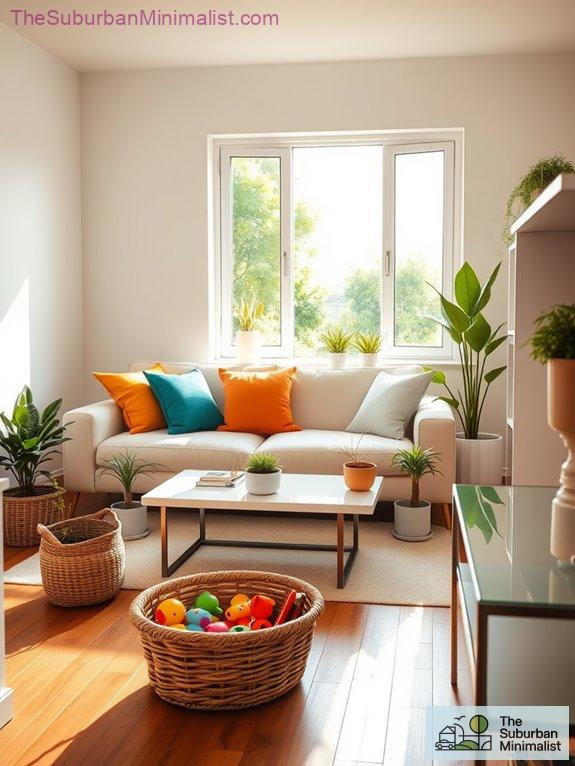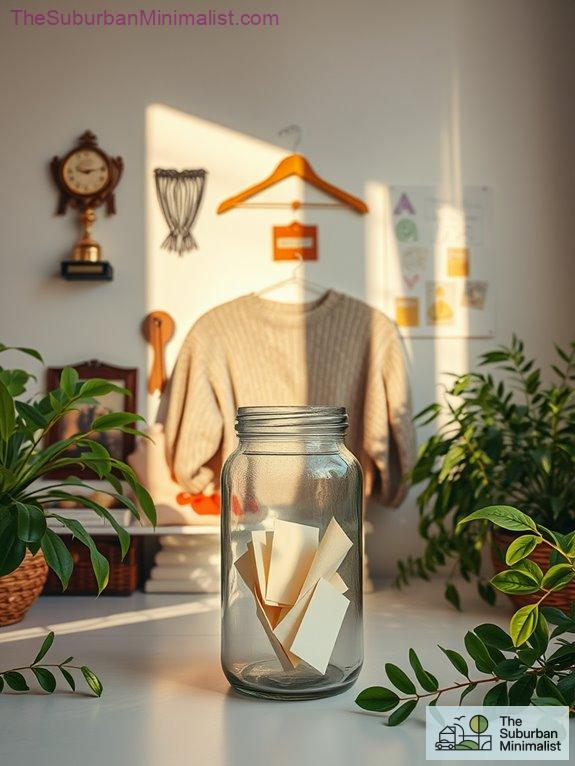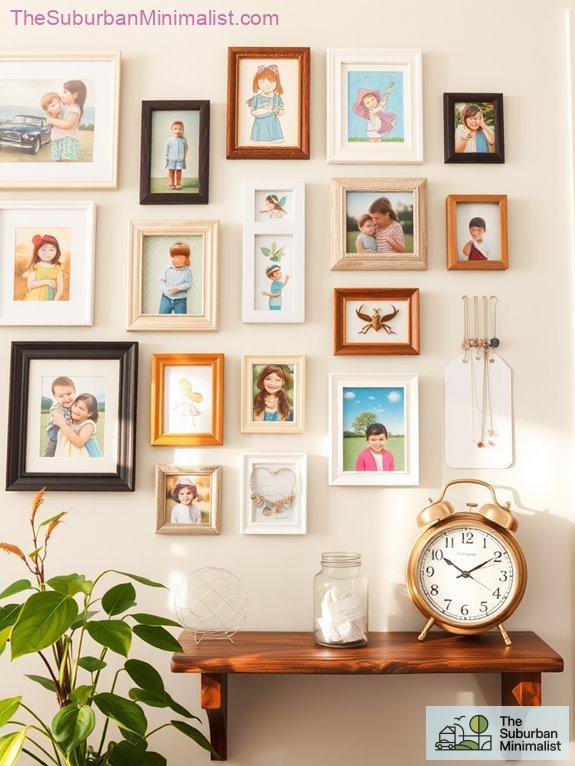Letting go of sentimental clutter? Sounds fun, right?
I used to hoard every crayon drawing my kids made. You know, just in case they become famous one day.
But then I realized—was I really keeping these treasures, or just the guilt of tossing them?
So, I started snapping pics of those masterpieces instead. Talk about liberating!
Now my home feels lighter, and I can finally see my dining table.
Curious how I did it? Let's dive in!
My Journey to Minimalism: A Real-Life Experience
You wouldn't believe the chaos in my closet! I found a collection of old clothes that I hadn't worn since the early 2000s. Honestly, why was I keeping that neon windbreaker?
One day, I decided enough was enough. I channeled my inner minimalist and tackled the mess. As I sorted, I felt a weight lift off my shoulders with each garment I let go.
The thrill of decluttering sparked my passion for minimalism, leading me to create The Suburban Minimalist. Now, I share tips and stories to help others embrace a life with less.
Because let's face it—less really is more!
Key Takeaways
- Gather all sentimental items in one place to assess their emotional value and make more informed decisions about what to keep or discard.
- Use a "one in, one out" rule to maintain balance and prevent new clutter from accumulating after decluttering sessions.
- Create a digital archive by photographing items, allowing you to preserve memories without the physical clutter occupying space.
- Schedule regular decluttering sessions to establish a consistent routine and prevent overwhelming buildup of sentimental items.
- Involve a friend to provide support and make the decluttering process more enjoyable while processing emotions related to sentimental items.
Begin With Non-Sentimental Spaces

When I first started tackling clutter, I found that focusing on non-sentimental spaces made all the difference.
Seriously, who knew that attacking the pile of broken toys or those mysterious dishes could spark joy? Embracing minimalism in your home can significantly enhance your living environment.
Using clutter strategies like this not only builds momentum but also gives you a sense of immediate accomplishment.
You know, the kind that makes you feel like you could conquer the world—or at least the living room.
Plus, clearing out the obvious stuff frees up brain space for when you face those tear-jerking sentimental items.
Trust me, it's a game-changer! Decluttering can lead to a more manageable and meaningful living space, allowing you to surround yourself with beloved items while maintaining balance.
Gather and Assess Items
Before diving into sentimental items, it's essential to gather everything in one go. Trust me, tackling these treasures in one swoop is the way to go! Otherwise, you'll spend more time looking for that childhood teddy bear than actually decluttering.
Here's what I recommend collecting:
- Birthday and anniversary cards
- Mementos from trips and events
- Children's artwork
- Childhood mementos
Once you've amassed your sentimental stash, you can assess their sentimental significance using some clever organizational strategies. Coping techniques can help in processing your emotions as you let go of certain items.
Grab a friend; it's way more fun and less painful to sift through memories together. As you hold each item, ask yourself: Does this spark joy or just dust? Remember, decluttering can reduce stress, and it's not a museum, it's your life!
Identify Emotional Triggers

Three key emotional triggers often surface as we sift through sentimental items: guilt, nostalgia, and fear.
Ever held onto something just because it once made you *feel*? Those memory triggers can really pack a punch!
I mean, who hasn't stared at a dusty trophy from high school and felt a twinge of guilt for letting it sit there?
Or that sweater from your first date, which now screams nostalgia louder than a vintage jukebox?
It's a wild ride, right?
Recognizing these emotional connections helps us understand why we cling to clutter. Physical clutter can compete for attention and hinder focus, adding to the emotional burden we feel. The process of decluttering can also serve as a form of emotional healing, as it allows us to confront and release those triggers. Fear of losing memories can keep us stuck, but don't let that hoard your happiness.
I created this website, The Suburban Minimalist, to help find joy in simplicity, not stress!
Ask Key Reflective Questions
Recognizing emotional triggers is just the first step; the next involves asking yourself key reflective questions that can guide your decision-making process.
When I tackle sentimental clutter, I find it helps to contemplate these questions:
- What memories does this item bring up?
- Am I keeping it out of genuine emotional attachment or just out of obligation?
- Does this object serve a purpose, or is it just collecting dust like my last New Year's resolution?
- If I let it go, will I miss it, or will I just feel lighter? Recognizing the emotional weight of inherited items can help clarify your feelings about what to keep or let go. Understanding the importance of decluttering sentimental treasures can also provide valuable insights into your emotions related to these items.
Document With Photos

When it comes to sentimental clutter, documenting items with photos can be a game-changer for both memory preservation and decluttering.
Seriously, who needs ten variations of the same macaroni art?
First, I sort items into categories—gifts, kids' masterpieces, and travel souvenirs.
Then, I snap high-quality photos and organize them in a digital archiving system. Recognizing the difference between attachment and necessity is crucial for effective decluttering, as it helps prioritize what truly matters. Documenting family heirlooms allows you to keep a record of meaningful items without the burden of physical space.
I can't stress enough how important it's to label and date them.
Creating a photo book or digital album makes memories accessible, and I can even add little stories beside each photo—because who doesn't want to retain that time my kid tried to "cook" with crayons?
Focus on Memories, Not Items
Moms often find themselves overwhelmed by the weight of sentimental items, but focusing on the memories behind those objects can provide a rejuvenating viewpoint. Remember that letting go of physical items can lead to a sense of freedom from guilt as you prioritize experiences over possessions.
Instead of clinging to every trinket, why not preserve the memories? Here are a few fun ideas:
- Write hilarious stories about that sweater Aunt Edna knitted you—recall the itchy fabric?
- Start a family blog or journal to keep track of those laughable moments.
- Express gratitude for gifts, even if they end up at the local donation center.
- Create digital archives of kids' artwork, so you can reminisce, but not trip over, their artistic genius. Remember, sentimental clutter can lead to stress and anxiety if not managed properly.
With a little bit of memory preservation and digital storytelling, I promise you can find joy in the memories, not just the items!
Why not give it a try?
Curate and Display Meaningful Keepsakes

Curating and displaying meaningful keepsakes can transform your home into a vibrant tapestry of memories.
I mean, who wouldn't want their walls to tell the story of that epic family trip or the time your kid's art graced the fridge? Memory displays can be a fun mix of framed photos, scrapbooks, and even that custom jewelry that makes you feel like a sentimental superhero.
Additionally, incorporating family heirlooms into your displays can deepen the connection to your family's history. And let's not forget about the "sensory time capsule"—because who doesn't want a whiff of grandma's cookies while reminiscing?
With a dash of sentimental organization, you can keep the clutter at bay and still celebrate those cherished moments. Meaningful gifts serve as physical reminders of shared experiences, allowing you to relive special times every time you pass by your displays.

Leave a Reply